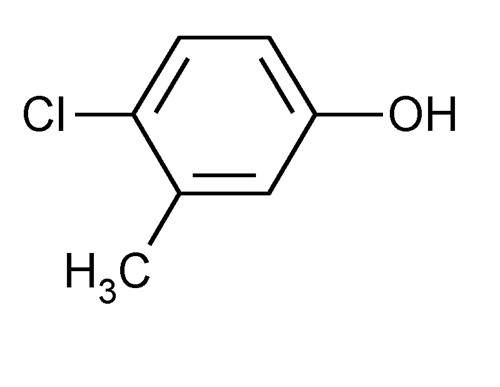Chlorocresol
» Chlorocresol contains not less than 99.0 percent and not more than 101.0 percent of C7H7ClO (4-chloro-3-methylphenol).
Packaging and storage—
Preserve in tight, light-resistant containers.
Completeness of solution—
Transfer 1 g to a test tube, add 0.4 mL of alcohol, and shake: solution is complete.
Identification—
A:
Add 40 mg to 10 mL of water, mix, and add 1 drop of ferric chloride TS: a blue color develops.
B:
Transfer 50 mg to a crucible, add 500 mg of anhydrous sodium carbonate, and mix. Heat the mixture until fused. Cool, add 5 mL of water, and boil. Acidify with 1 mL of nitric acid, filter, and add 1 mL of silver nitrate TS to the filtrate: a white precipitate is formed.
Limit of nonvolatile residue—
Heat about 1.0 g, accurately weighed, in a tared crucible on a steam bath until it has evaporated, and dry the residue at 105 for 1 hour: not more than 0.1% of residue remains.
for 1 hour: not more than 0.1% of residue remains.
Assay—
Transfer about 70 mg of Chlorocresol, accurately weighed, to an iodine flask, add 30 mL of glacial acetic acid, 25.0 mL of 0.1 N bromine VS, 10 mL of potassium bromide solution (3 in 20), and 10 mL of hydrochloric acid. Immediately insert the stopper, mix, and allow to stand for 15 minutes, protected from light. Quickly add 10 mL of potassium iodide solution (1 in 10) and 100 mL of water, taking precautions against the escape of bromine vapor, at once insert the stopper, and shake the mixture thoroughly. Remove the stopper, and rinse it and the neck of the flask with a small quantity of water so that the washing flows into the flask. Add 1 mL of chloroform, shake the mixture thoroughly, and titrate the liberated iodine with 0.1 N sodium thiosulfate VS, adding 3 mL of starch TS as the endpoint is approached. Perform a blank determination (see Residual Titrations under Titrimetry  541
541 ). Each mL of 0.1 N bromine is equivalent to 3.565 mg of C7H7ClO.
). Each mL of 0.1 N bromine is equivalent to 3.565 mg of C7H7ClO.
Auxiliary Information—
Please check for your question in the FAQs before contacting USP.
Chromatographic Column—
| Topic/Question | Contact | Expert Committee |
| Monograph | Robert H. Lafaver, B.A.
Scientist 1-301-816-8335 |
(EM105) Excipient Monographs 1 |
USP32–NF27 Page 1206
Chromatographic columns text is not derived from, and not part of, USP 32 or NF 27.
